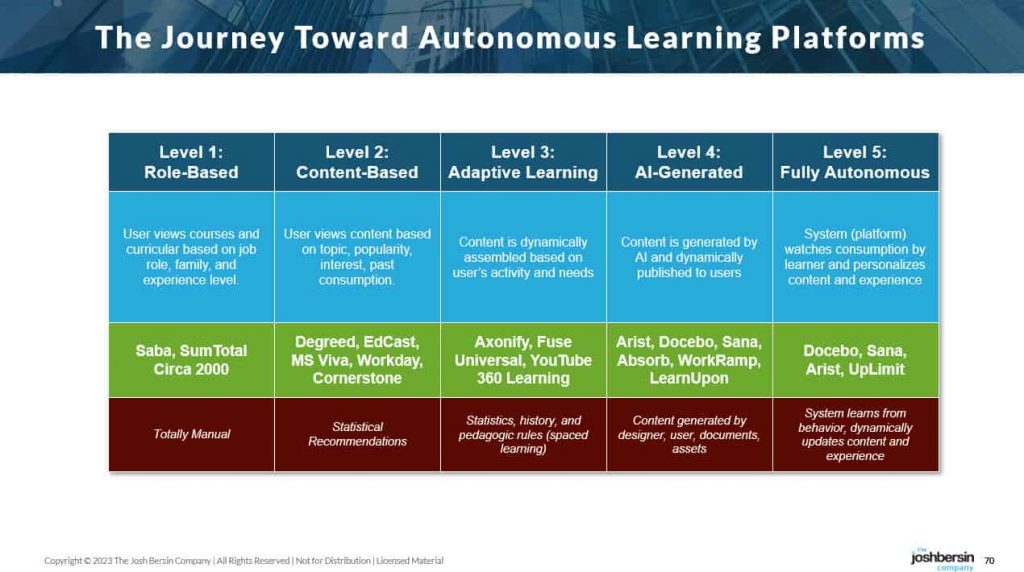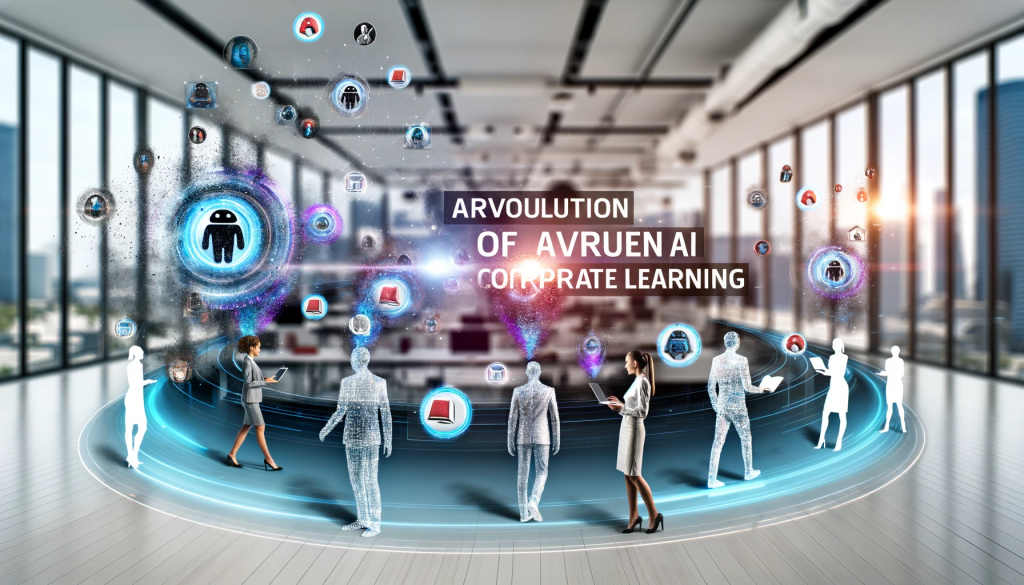Thanks to Generative AI, we’re about to see the biggest revolution in corporate learning since the invention of the internet. And this new world, which will bring together personalization, knowledge management, and a delightful user experience, is long overdue.
I’ve been working in the corporate learning market since 1998, when the term “e-learning” was invented. And every innovation since that time has been an attempt to make training easier to build, easier to consume, and more personalized. Many of the innovations were well intentioned, but often they didn’t work as planned.
First came role based learning, then competency-driven training and career-driven programs. These worked great, but they couldn’t adapt fast enough. So people resorted to short video, YouTube-style platforms, and then user-authored content. We then added mobile tools, highly collaborative systems, MOOCs, and more recently Learning Experience Platforms. Now everyone is focused on skills-based training, and we’re trying to take all our content and organize it around a skills taxonomy.
Well I’m here to tell you all this is about to change. While none of these important innovations will go away, a new breed of AI-powered dynamic content systems is going to change everything. And as a long student of this space, I’d like to explain why. And in this conversation I will discuss four new vendors, each of which prove my point (Sana, Docebo, Uplimit, and Arist).
The Dynamic Content Problem: Instructional Design By Machine
Let’s start with the problem. Companies have thousands of topics, professional skills, technical skills, and business strategies to teach. Employees need to learn about tools, business strategies, how to do their job, and how to manage others. And every company’s corpus of knowledge is different.
Rolls Royce, a company now starting to use
Galileo, has 120 years of engineering, technology, and manufacturing expertise embedded in its products, documentation, support systems, and people. How can the company possibly impart this expertise into new engineers? It’s a daunting problem.
Every company has this issue. When I worked at Exxon we had hundreds of manuals explaining how to design pumps, pressure vessels, and various refinery systems. Shell built a massive simulation to teach production engineers how to understand geology and drilling. Starbucks has to teach each barista how to make thousands of drinks. And even Uber drivers have to learn how to use their app, take care of customers, and stay safe. (They use Arist for this.)
All these challenges are fun to think about. Instructional designers and training managers create fascinating training programs that range from in-class sessions to long courses, simulations, job aids, and podcasts. But as hard as they try and as creative as they are, the “content problem” keeps growing.
Right now, for example, everyone is freaked out about AI skills, human-centered leadership, sustainability strategies, and cloud-based offerings. I’ve never seen a sales organization that does quite enough training, and you can multiply that by 100 when you think about customer service, repair operations, manufacturing, and internal operations.
While I always loved working with instructional designers earlier in my career, their work takes time and effort. Every special course, video, assessment, and learning path takes time and money to build. And once it’s built we want it to be “adaptive” to the learner. Many tools have tried to build adaptive learning (from Axonify to Cisco’s “
reusable learning objects“) but the scale and utility of these innovations is limited.
What if we use AI and machine learning to simply build content on the fly? And let employees simply ask questions to find and create the learning experience they want? Well thanks to innovations from the vendors I mentioned above, this kind of personalized experience is available today. (Listen to my
conversation with Joel Hellermark from Sana to hear more.)
What Is An Autonomous Learning Platform?
The best analogy I’ve come up with is the “
five levels of autonomous driving.” We’re going from “no automation” to “driver assist” to “conditional automation” to “fully automated.” Let me suggest this is precisely what’s happening in corporate training.

If you look at the pace of AI announcements coming (custom GPTs, image and video generation, integrated search), you can see that this reality has now arrived.
How Does This Really Work
Now that I’ve had more than a year to tinker with AI and talk with dozens of vendors, the path is becoming clear. The new generation of learning platforms (and yes, this will eventually replace your LMS), can do many things we need:
First, they can dynamically index and injest content into an LLM, creating an “expert” or “tutor” to answer questions. Galileo, for example, now speaks in my own personal voice and can answer almost any question in HR I typically get in person. And it gives references, examples, and suggests follow-up questions. Companies can take courses, documents, and work rules and simply add them to the corpus.
Second, these systems can dynamically create courses, videos, quizzes, and simulations. Arist’s tool builds world-class instructional pathways from documents (try our
free online course on Predictions 2024 for example) and probably eliminates 80% of the design time. Docebo Shape can take sales presentations and build an instructional simulation automatically, enabling sales people to practice and rehearse.
Third, they can give employees interactive tutors and coaches to learn. Uplimit’s new system, which is designed for technical training, automatically gives you an LLM-powered coach to step you through exercises, and it learns who you are and what kind of questions you need help with. No need to “find the instructor” when you get stuck.
Fourth, they can personalize content precisely for you. Sana’s platform, which Joel describes here, can not only dynamically generate content but by understanding your behavior, can actually give you a personalized version of any course you choose to take.
These systems are truly spectacular. The first time you see one it’s kind of shocking, but once you understand how they work you see a whole new world ahead.
Where Is This Going
While the market is young, I see four huge opportunities ahead.
First, companies can now take millions of hours of legacy content and “republish it” in a better form. All those old SCORM or video-based courses, exercises, and simulations can turn into intelligent tutors and knowledge management systems for employees. This won’t be a simple task but I guarantee it’s going to happen. Why would I want to ramble around in the LMS (or even LinkedIn Learning) to find the video, or information I need? I”d just like to ask a system like Galileo to answer a question, and let the platform answer the question and take me to the page or word in the video to watch.
Second, we can liberate instructional design. While there will always be a need for great designers, we can now democratize this process, enabling sales operations people, and other “non-designers” to build content and courses faster. Projects like video authoring and video journalism (which we do a lot in our academy) can be greatly accelerated. And soon we’ll have “generated VR” as well.
Third, we can finally integrate live learning with self-directed study. Every live event can be recorded and indexed in the LLM. A two hour webinar now becomes a discoverable learning object, and every minute of explanation can be found and used for learning. Our corpus, for example, includes hundreds of hours of in-depth interviews and case studies with HR leaders. All this information can be brought to life with a simple question.
Fourth, we can really simplify compliance training, operations training, product usage, and customer support. How many training programs are designed to teach someone “what not to do” or “how to avoid breaking something” or “how to assemble or operate” some machine? I’d suggest its millions of hours – and all this can now be embedded in AI, offered via chat (or voice), and turned loose on employees to help them quickly learn how to do their jobs.
Vendors Watch Out
This shift is about as disruptive as Tesla has been to the big three automakers. Old LMS and LXP systems are going to look clunkier than ever. Mobile learning won’t be a specialized space like it has been. And most of the ERP-delivered training systems are going to have to change.
Sana and Uplimit, for example, are both AI-architected systems. These platforms are not “LMSs with Gen AI added,” they are AI at the core. They’re likely to disrupt many traditional systems including Workday Learning, SuccessFactors, Cornerstone, and others.
Consider the content providers. Large players like LinkedIn Learning, Skillsoft, Coursera, and Udemy have the opportunity to rethink their entire strategy, and either put Gen AI on top of their solution or possibly start with a fresh approach. Smaller providers like us (and thousands of others) can take their corpus of knowledge and quickly make it come to life. (There will be a massive market of AI tools to help with this.)
I’m not saying this is easy. If you talk with vendors like Sana, Docebo, Arist, and Uplimit, you see that their AI platforms have to be highly tuned and optimized for the right user experience. This is not as simple as “dumping content into ChatGPT,” believe me.
But the writing is on the wall, Autonomous Learning is coming fast.
As someone who has lived in the L&D market for 25 years, I see this era as the most exciting, high-value time in two decades. I suggest you jump in and learn, we’ll be here to help you along the way.
About These Vendors
Sana (Sana Labs) is a Sweden-based AI company that focuses on transforming how organizations learn and access knowledge. The company provides an AI-based platform to help people manage information at work and use that data as a resource for e-learning within the organization. Sana Labs’ platform combines knowledge management, enterprise search, and e-learning to work together, allowing for the automatic organization of data across different apps used within an organization.
Docebo is a software as a service company that specializes in learning management systems (LMS). It was founded in 2005 and is known for its Docebo Learn LMS and other tools, including Docebo Shape, its AI development system. The company has integrated learning-specific artificial intelligence algorithms into its platform, powered by a combination of machine learning, deep learning, and natural language processing. The company went public in 2019 and is listed on the Toronto Stock Exchange and the Nasdaq Global Select Market.
Uplimit is an online learning platform that offers live group courses taught by top experts in the fields of AI, data, engineering, product, and business. The platform is known for its AI-powered teaching assistant and personalized learning approach, which includes real-time feedback, tailored learning plans, and support for learners. Uplimit’s courses cover technical and leadership topics and are designed to help individuals and organizations acquire the skills needed for the future.
Arist is a company that provides a text message learning platform, allowing Fortune 500 companies, governments, and nonprofits to rapidly teach and train employees entirely via text message. The platform is designed to deliver research-backed learning and nudges directly in messaging tools, making learning accessible and effective. Arist’s approach is inspired by Stanford research and aims to create hyper-engaging courses in minutes and enroll learners in seconds via SMS and WhatsApp, without the need for a laptop, LMS, or internet. The company has been recognized for its innovative and science-backed approach to microlearning and training delivery.
BY
JOSHBERSIN







 扫一扫
添加客服
扫一扫
添加客服




